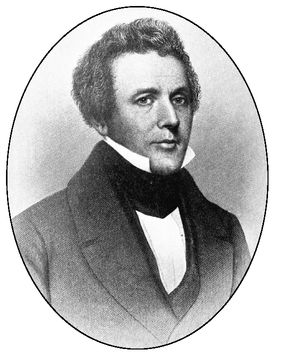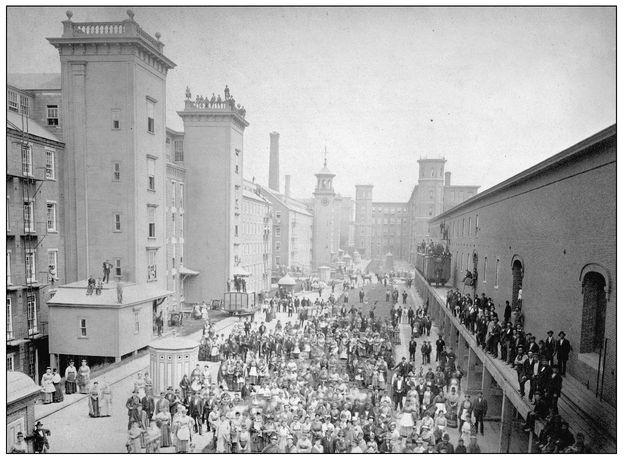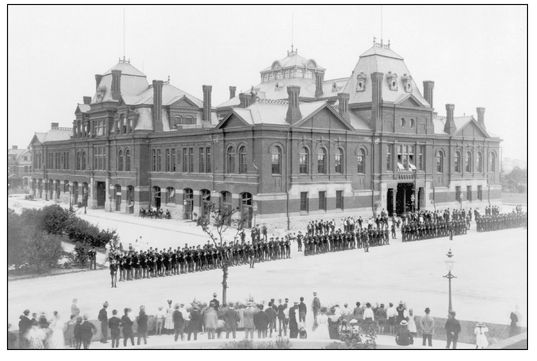The Company Town (21 page)
Authors: Hardy Green

McMurtry was not present for these events. Instead, he was in Europe visiting celebrated model industrial towns, including the Krupp estates near Essen, Germany, various English factory villages, and the foundries at Le Creusot, France. His trip was not unlike the grand tours taken by Francis Cabot Lowell and Milton Hershey. McMurtry saw landscaped European towns in which companies provided schools, housing, and social programs.
Two years after returning to the United States, McMurtry hired the celebrated landscape architecture firm of Olmsted, Olmsted and Eliot to design a model industrial town for him. The legendary Frederick Law Olmsted Sr. had made his reputation with the rolling landscapes and rustic motifs of New York's Central Park and pastoral middle-class suburbs.
Olmsted's successors, partner Charles Eliot and stepson John Charles Olmsted, envisioned for McMurtry a town of curvilinear boulevards dominated by a large village green.
Olmsted's successors, partner Charles Eliot and stepson John Charles Olmsted, envisioned for McMurtry a town of curvilinear boulevards dominated by a large village green.
McMurtry had stipulated that the new town would have a modern sanitary infrastructure, including water mains, sewers, and gas lines, all of which he believed would mean a stronger, healthier workforce. Like Apollo, and for that matter like Homestead and Braddock, the company would not build housing for workers, instead leaving this to private interests. Lest this have the same undesirable result as in the other towns, the Olmsted consultants recommended a series of restrictive covenants that would define the use of town space and ensure that only desirable structures were built. They would, for example, bar tenements and stipulate the size of yards, and all houses would require approval by a board of architects.
Immediately, McMurtry began tinkering with the designers' grand vision. More and more space would be needed for the mill itself, he determined, much of which came at the expense of the greensward. As for the restrictive covenants, he approved only one: barring the sale of liquor. The town, he decreed, would be named Vandergrift in honor of Apollo's largest investor, Jacob Jay Vandergrift Sr.
It wasn't long before the architects washed their hands of the project. But Apollo's board at least was pleased with the outcome. The board set up a separate company to handle real estate, the Vandergrift Land and Improvement Co., and within six months of its announcement of lots for sale in the budding town, two-thirds of residential properties had been sold. This meant Apollo had practically recouped all of its $200,000 initial investment.
The land company carefully evaluated all prospective property buyers, with an eye primarily to weeding out any union men, and it advanced money to help those it favored build homes. Supervisors and skilled operatives made up the ranks of the first buyers. The land company built a good number of houses to be rentals. Even so, the size of lots and their $750 price tag meant that only elite workers could afford to live in Vandergrift's main residential area. The town soon offered a second subdivision, dubbed Vandergrift Heights, and in time that $150-per-lot area filled up with housing built for lower paid operatives. In a third area,
Morning Sun, immigrant laborers settled, and that region grew into a facsimile of the “Hunkytowns” common among the steel communities of Pennsylvania.
7
In a
Harper's Weekly
article saluting Vandergrift, Eugene Buffington described how the foreigners had “segregated themselves . . . on the outskirts of the borough,” requiring Vandergrift officials to keep an eye on their sanitary habits and enforce “regulations for cleanliness and health.”
8
Morning Sun, immigrant laborers settled, and that region grew into a facsimile of the “Hunkytowns” common among the steel communities of Pennsylvania.
7
In a
Harper's Weekly
article saluting Vandergrift, Eugene Buffington described how the foreigners had “segregated themselves . . . on the outskirts of the borough,” requiring Vandergrift officials to keep an eye on their sanitary habits and enforce “regulations for cleanliness and health.”
8
Vandergrift borough was incorporated in 1897, and citizens elected a town council to set a tax levy and to hire a constable and policeman. On more substantive matters, the council, which consisted of skilled workers from the mill, regularly deferred to the company. McMurtry agreed to provide a firehouse and a cemetery, and to donate land for the seven churches that were established by 1903.
Vandergrift was far from exhibiting the tidy, model looks of Pullman, Hershey, or early Lowell. Those who bought lots in Vandergrift immediately began subdividing them and constructing rental housing, while Vandergrift Heights was notable for its rutted, unpaved streets, cowsheds, and privies. But homeownership in the area seemed to have the effect the steel managers desired: A 1901 strike called by the Amalgamated drew little support in Vandergrift, where a union observer found the employees to be “bound up by their property interests.” The strike's failure there offered McMurtry a “crowning vindication,” raved trade journal
Iron Age
: “With such a splendid proof of the value of an industrial town laid out on modern lines, and of a management fostering close relations with the men based on absolutely fair dealing, it is to be hoped that in the future Vandergrift will have the distinction of being only the oldest of a series of similar communities.”
Iron Age
: “With such a splendid proof of the value of an industrial town laid out on modern lines, and of a management fostering close relations with the men based on absolutely fair dealing, it is to be hoped that in the future Vandergrift will have the distinction of being only the oldest of a series of similar communities.”
As further evidence of the community's harmonious labor relations, in 1902 Vandergrift citizens held a ceremony in which they presented McMurtry with a silver punch bowl. Engraved thereupon were the words A TRUE FRIEND OF THE WORKING MAN.
9
9

An instinctive American “self-helpfulness” prompted Vandergrift workers to build their own houses, Buffington said. Surely that impulse, the
town's homeowner spirit, and its company loyalty could be duplicated at Gary, the corporation figured.
town's homeowner spirit, and its company loyalty could be duplicated at Gary, the corporation figured.
Accordingly, it established the independent Gary Land Co., resembling the Vandergrift Land and Improvement Co., under executive Horace S. Norton. Following a $7.2 million anonymous land purchase of nearly twenty square miles, including eight miles of Lake Michigan shore frontage, the Gary Land Co. filled in seven hundred feet of the lake, dredged a twenty-five-foot ship canal a mile inland, and relocated a straightened and narrowed Grand Calumet River a half mile southward. Indiana Steel, with its eight blast furnaces, fifty-six open hearths, coke ovens, and the largest rail mill in the world, was the first plant to be constructed and became the nucleus of the industrial complex. It would be flanked by American Sheet and Tin Plate's factory and that of National Tube, with the Universal Portland Cement factory located farther to the west along the shore. Located slightly inland were the American Bridge and American Locomotive plants. The Elgin, Joliet & Eastern Railwayâwhich circled Chicago's outer rim and connected the Gary Works with Illinois Steel finishing plants in south Chicagoâlocated its terminal yards at the southwest corner of the industrial area.
10
10
As for the town, the Land Co. hired no city planners, merely turning over the layout to engineer A. P. Melton. There would be no curvilinear boulevards or pastoral inspiration in Gary. Instead, Melton plotted the town as an unvarying grid centered on an axis of Broadwayâthe thoroughfare that ran straight south from the front entrance of the Indiana Steel plantâand the east-west commercial street called Fifth Avenue. The avenues south of Fifth would simply be numbered; the streets running parallel to Broadway would get the names of U.S. presidents and states. The Land Co. built a sewer system sufficient for a city of 200,000 and later would donate land for schools, churches, a library, a hospital, and municipal buildings.
By June 1906, hundreds of men were at work building the new town. Adjacent to each company's property, Melton plotted subdivisions for its workers' homes. The first subdivision, intended for Indiana Steel, consisted of eight hundred acres immediately to the south of the mill site, plotted into 4,000 lots. Streets were graded and paved, concrete sidewalks
built, sewers dug, and electric and gas lines installed. Lot-sale agreements stipulated simply that building plans had to be approved by an agent of the Land Co., that houses had to be completed within twelve to eighteen months, and that, with very few exceptions, no liquor could be sold. (Five sites obtained exemptions from this prohibition, Buffington explained, as a safety valve necessary to a large town, since the foreign element “would otherwise be enticed to groggeries of the lowest type.”) But unlike in Vandergrift, this near-laissez-faire approach was not greeted with an explosion of home-building. Instead, within three years only 250 private homes had been constructed.
built, sewers dug, and electric and gas lines installed. Lot-sale agreements stipulated simply that building plans had to be approved by an agent of the Land Co., that houses had to be completed within twelve to eighteen months, and that, with very few exceptions, no liquor could be sold. (Five sites obtained exemptions from this prohibition, Buffington explained, as a safety valve necessary to a large town, since the foreign element “would otherwise be enticed to groggeries of the lowest type.”) But unlike in Vandergrift, this near-laissez-faire approach was not greeted with an explosion of home-building. Instead, within three years only 250 private homes had been constructed.
Consequently, the Gary Land Co. soon found itself in the home-construction business, erecting around eight hundred homes that rented for anywhere from $42 to $14 per month. Many of these were houses of five to ten rooms, and, as in Vandergrift proper, the rents made them affordable only to executives and the most skilled workers. Beginning in 1909, the company built three hundred apartment houses for workers at American Bridge and more than one hundred single homes for American Sheet and Tin Plate employees.
It was a departure when the company constructed fifty uniform, wood-frame, four-room houses in a corner of the first subdivision. With rents a bit lowerâ$12 to $13 per monthâless-skilled, lower-paid workers could afford to live there. But fifty units hardly put a dent in the need for inexpensive housing, and in any case, Land Co. executives decided they did not approve of the results and in 1911 tore down the alreadydisheveled structures. The majority of Gary's 16,000 low-paid immigrant workers had to fend for themselves. Many commuted from Pullman, a twelve-mile round trip.
Finally, private enterprise stepped inâexhibiting its least attractive attributes. The South Side area beyond U.S. Steel's property but still within Gary's incorporated limits beckoned to real estate promoters, including the president of the town board, a pol by the name of Tom Knotts, whose older brother Armanis had organized the original, anonymous land purchase for U.S. Steel. Tom Knottsâwho once likened his real estate success to “picking leaves from trees”âensured that land lying to the south would soar in value by seeing to it that the town's streetcar franchise went to an ally. The Gary and Interurban Railway Co. went on to build a Broadway-centered, north-south line, not the Fifth Avenue- oriented, east-west line the Land Co. preferred. Then, Knotts and others built hundreds of South Side boardinghouses and cheap frame houses for the immigrant workers. The results were slums, given that there were no restrictions on lot sizes and no codes requiring running water, toilets, or sewers. Typical were the one hundred-foot-by-eighteen-foot shacks split up into two-room units, each of which rented for $6 to $9 per month. And unlike Vandergrift and the subdivisions of the Gary Land Co., the South Side had no limitations on drinking establishments. By 1908, there were eighty-seven saloons on Broadway alone. An infamous area known as “the Patch” emerged just south of the Wabash Railroad tracks, which defined one edge of the Land Co.'s holdings. By 1911, Gary featured one saloon for every eighty-eight citizens; in Chicago working-class wards, the ratio was 1 to 231.
11
11

Kirk Boott, the great potentate of the early days of Lowell, Massachusetts.

Lowell's Boott Mills in the late 1800s.

Other books
So Many Roads by David Browne
Dark Halo (An Angel Eyes Novel) by Dittemore, Shannon
He's the One by Linda Lael Miller
The Love Goddess' Cooking School by Melissa Senate
DeliciousDanger by Desiree Holt
A Splash of Red by Antonia Fraser
Stabbing Stephanie by Evan Marshall
The Day the Streets Stood Still by JaQuavis Coleman
OvercomingtheNeed by Zenobia Renquist
Totally Tormented by Lucy Covington
